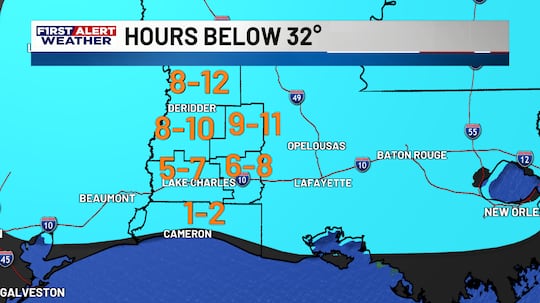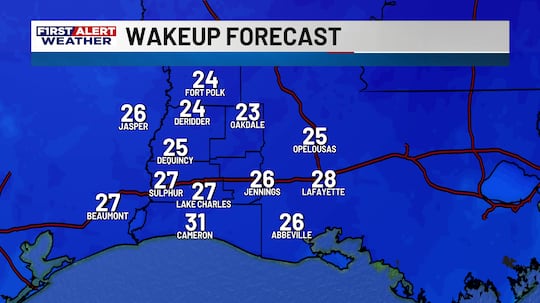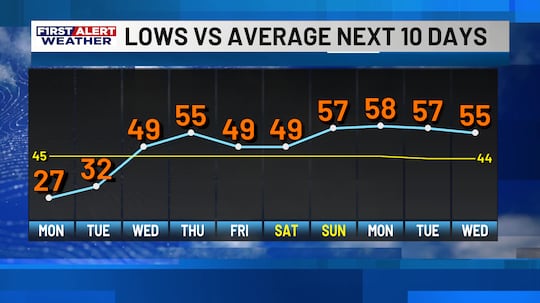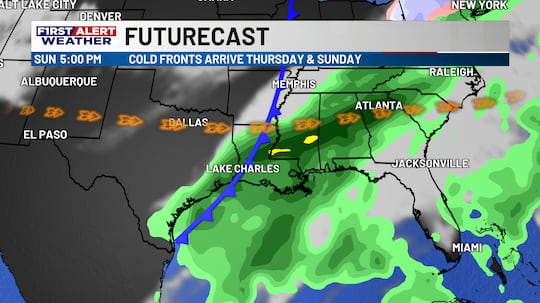Louisiana
Federal judges give Louisiana lawmakers until June 3 to create suitable new congressional map

NEW ORLEANS (WVUE) – Louisiana lawmakers have less than a month to come up with a new congressional map or a panel of judges will draw it for them.
That mandate comes from a three-person panel of federal appellate judges who threw out the legislature’s newest map just last week.
Time is short because district lines need to be set in time for fall congressional elections.
The panel of judges gave state lawmakers until June 3 to present an acceptable congressional map, or have one imposed on them instead.
The panel last week rejected a map passed during a January special legislative session, which would have created Louisiana’s second Black-majority district. The panel found by a 2-1 vote that race was the predominant factor in that map’s boundaries, which the judges said violated the equal protection clause of the 14th Amendment.
Meanwhile, the judges will be making their own remedial plan, in case the lawmakers fail to act in time.
A spokesperson for Secretary of State Nancy Landry, however, said the June 3 deadline is too lax. The office said May 15 is its hard deadline to implement a map for the November election ballots.
Attorney General Liz Murrill said the state is appealing to the US Supreme Court to have the rejected map reinstated.
“Today, three federal judges who never spent a day running an election have ignored uncontradicted testimony that we need a map by May 15, and once again turned Louisiana’s congressional elections upside down,” Murrill said in a statement released Tuesday. “That’s on the tails of another federal judge, the 5th Circuit, and the Supreme Court doing it in the last round of congressional elections.
“At a time when concerns about election integrity are higher than ever, this ruling threatens the ability of the Secretary of State to conduct a stable and fair election in a presidential election year in Louisiana. We will be heading this week to the US Supreme Court.”
Davante Lewis, the Public Service Commissioner for the 3rd district of Louisiana, said Murrill’s statement is nonsensical and accused the AG of using bombastic language.
Lewis said the court gave the secretary of state and the state an opportunity Monday night to file briefs explaining their concerns about moving the deadline past the original date of May 15. However, he said the judges felt their testimony was not compelling, because both had mentioned in other cases they could have a map as late as May or early June.
Lewis said Louisiana will have a map in place before November. But what that map looks like is still up in the air.
“Everyone wants a map that is fair and just to the people of Louisiana, that adequately represents the population and gives every Louisianan the opportunity to have a member of congress of their choosing,” Lewis said.
“How you get there varies. There are multiple ways you can get there. I think what we have to do at this moment is keep our eyes on the prize that a fair map is needed. And, whatever the courts do, that they ensure that all Louisianans are fairly represented and that this legal strategy and legal confusion does not end in another election of people not having their voices adequately represented in Washington DC.”
See a spelling or grammar error in our story? Click Here to report it. Please include the headline.
Subscribe to the Fox 8 YouTube channel.
Copyright 2024 WVUE. All rights reserved.

Louisiana
First Alert Forecast: Coldest Night of Season in Southwest Louisiana — Here’s What You Need to Know

LAKE CHARLES, La. (KPLC) – After enjoying mild weather in the 70s just yesterday, southwest Louisiana is bracing for the coldest night of the season so far, with temperatures expected to plunge well below freezing overnight and wind chills dipping into the teens.
What to Expect Tonight
Temperatures will vary depending on where you live in southwest Louisiana:
Inland areas north of I-10: Temperatures will drop below 32 degrees for 8 to 12 hours, with wind chills potentially reaching the upper teens.
Along I-10: Freezing conditions expected for 5 to 8 hours.
Coastal areas: Temperatures will dip below freezing for 1 to 2 hours, with the least severe impacts.
Monday morning will be brutally cold to start, but temperatures will gradually warm into the low 50s by afternoon as the sun rises.
Protect Your Pipes
The most immediate concern for homeowners is frozen water pipes. Here’s what you need to know:
If you’ve never had pipe problems before: You likely won’t experience issues tonight. Pipes typically only freeze when temperatures stay below 25 degrees for several hours.
If you’ve had problems in the past: Take precautions now. Cover exposed pipes or leave a faucet dripping slowly. Once temperatures rise above freezing, stop dripping the faucet to avoid wasting water.
Use common sense and assess your home’s vulnerable areas. Every situation is different.
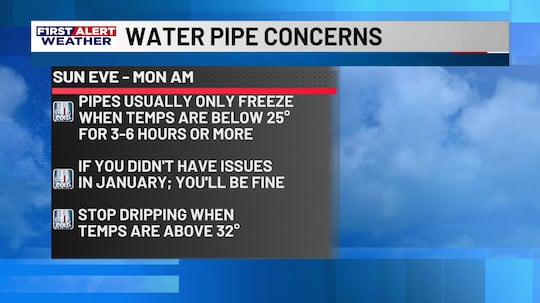
Other Safety Reminders
- Outdoor pets: Bring them inside if possible, or ensure they have adequate shelter and unfrozen water.
- Check on neighbors and friends: Make sure elderly relatives and those living alone are staying warm and safe.
- Test your smoke detector: Cold weather increases the use of heating sources — make sure your smoke detector is working properly.
- Dress in layers: If you’ll be outside, bundle up. Wind chills will make it feel significantly colder than the actual temperature.
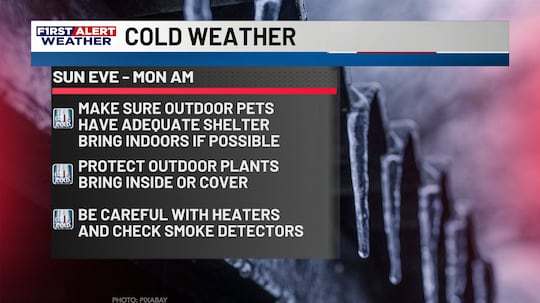
Looking Ahead
The good news? This cold snap won’t last long. Southerly winds should return as early as Tuesday afternoon, gradually warming temperatures back toward normal.
However, Monday night into Tuesday morning will bring widespread frost with calm winds and temperatures in the 30s.
Another cold front is expected to move through Wednesday night into Thursday, bringing scattered showers. This system won’t be as severe as today’s front, but temperatures will drop slightly by week’s end.
A third cold front may arrive Sunday with scattered showers and possibly a few thunderstorms, though impacts appear minimal.
By Thursday and Friday, temperatures will rebound into the 70s before cooling slightly over the weekend.
Copyright 2025 KPLC. All rights reserved.
Louisiana
Three takeaways from LSU women’s basketball’s win over Louisiana Tech

LSU women’s basketball started slow but recovered Saturday against Louisiana Tech, head coach Kim Mulkey’s alma mater. Inside New Orleans’ Smoothie King Center, the No. 5 Tigers won 87-61 to improve to 11-0.
Mikaylah Williams led the team with 19 points while Flau’Jae Johnson notched her first double-double of the season with 13 points and 10 rebounds. Kate Koval and MiLaysia Fulwiley finished with 19 and 10 points, respectively. Jada Richard dished out a game-high eight assists.
Grace Knox, in the first start of her college career, scored four points as part of a 6-0 opening run for LSU, but three three-pointers put Louisiana Tech up with 7:19 on the clock. Back-and-forth play ensued, but the Lady Techsters led by two at the end of the first quarter. They hung around on the glass as well, limiting the Tigers to one and done most times.
LSU woke up in the second quarter and began imposing its physicality. Louisiana Tech didn’t score until the 5:34 mark and racked up fouls, including two on sharp-shooter Paris Bradley. The Tigers were in the bonus for over half of the second quarter but experienced a near-three-minute scoring drought, letting the Lady Techsters hang around. LSU led by nine points heading into the locker room. Both teams shot under 40% in the opening 20 minutes.
Louisiana Tech kept the game within reach for much of the third quarter but it eventually got away. LSU ended the frame on a 9-0 run and built a 20-point lead for good a minute into the fourth. Turnovers and mental mistakes piled up for the Lady Techsters, which gave the Tigers more chances to push the pace of play. The Tigers went on a 14-2 run over four minutes when substitutes started rolling in. They shot 58.6% in the second half.
LSU lacked success in transition
LSU relies on getting into track meets with opponents quickly to build a comfortable cushion. That didn’t happen Saturday as Louisiana Tech hit its shots to open the game. Even when the Lady Techsters missed, they were comfortable going one-and-done most times as they prioritized getting numbers back to defend. That’s how they kept the score close in the early goings.
In the first half, LSU scored just six points in transition and 11 points off turnovers. The Tigers stepped up on the defensive end in the second half. Even though they didn’t produce the fast break opportunities they’re used to, they were more patient on the offensive end and knocked down their open shots.
Koval, Joyner didn’t get enough touches
As in most of its nonconference games, LSU possesses a substantial size advantage inside. That was the case Saturday but the purple and gold struggled to get the ball inside to Koval and Joyner. When the pair had touches, they often either finished, kicked out for an open shot, or drew a foul. They combined for 21 points on 21 shots from the field and 10 free-throw attempts. LSU scored just 36 points in the paint over the entire game.
Likely driven by Mulkey’s comments at the break. LSU made a concerted effort to pounce on the ball inside. Koval scored over half of her points in the final two quarters. She easily worked with passes over the top of Louisiana Tech’s Averi Aaron and in the high-low when the Lady Techsters went to a zone. The Tigers need to learn from their lack of post play and use their advantage inside, especially as they prepare to play in the SEC.
Williams led LSU throughout the game
LSU struggled to find rhythm on both ends of the court in the early goings but Williams put the team on her back in the middle two frames. She scored 13 points, including two triples, on four of seven shots from the field. She added five rebounds and three assists over the same span.
Williams played a team-high 32 minutes on Saturday and she played all but two minutes in the first half. The junior displayed much-needed poise to an LSU team that couldn’t settle into the way it wanted to play initially. She also locked in on the defensive end, switching onto Bradley and locking her down for the back half of the contest. Her play in all facets gave the Tigers the confidence that they needed to pull ahead in the second half.
Louisiana
Photos: LSU women defeats Louisiana Tech in the Smoothie King Center, 87-61

Kramer Robertson, son of Kim Mulkey, New Orleans Pelicans and Saints owner Gayle Benson and Mayor-Elect Helena Moreno sit on the sidelines during the first half of a Compete 4 Cause Classic basketball game between the Louisiana State Tigers and the Louisiana Tech Lady Techsters at the Smoothie King Center in New Orleans, Saturday, Dec. 13, 2025. (Photo by Sophia Germer, The Times-Picayune)
-

 Alaska1 week ago
Alaska1 week agoHowling Mat-Su winds leave thousands without power
-

 Texas1 week ago
Texas1 week agoTexas Tech football vs BYU live updates, start time, TV channel for Big 12 title
-

 Washington6 days ago
Washington6 days agoLIVE UPDATES: Mudslide, road closures across Western Washington
-

 Iowa1 week ago
Iowa1 week agoMatt Campbell reportedly bringing longtime Iowa State staffer to Penn State as 1st hire
-

 Miami, FL1 week ago
Miami, FL1 week agoUrban Meyer, Brady Quinn get in heated exchange during Alabama, Notre Dame, Miami CFP discussion
-

 Iowa2 days ago
Iowa2 days agoHow much snow did Iowa get? See Iowa’s latest snowfall totals
-

 Cleveland, OH1 week ago
Cleveland, OH1 week agoMan shot, killed at downtown Cleveland nightclub: EMS
-
World1 week ago
Chiefs’ offensive line woes deepen as Wanya Morris exits with knee injury against Texans








